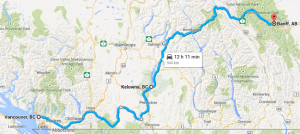By: Kathleen Lortie
It might seem odd that Kelowna, a formerly isolated and rural settlement would go on to become the province’s primary link between the Lower Mainland and neighboring Alberta. Today, the booming agriculture, tech, and tourism sectors continue to keep the money and human traffic flowing.
Diving into the Okanagan Historical Society’s annual reports, one finds the local economy owes much of this success to a floating, 650-meter long concrete bridge.
The William R. Bennett Bridge, formerly known as the Okanagan Lake Bridge, is said to be the “economic lifeline” of the city. Built in 1958, the pontoon bridge connecting the downtown end to the west side is crucial for the movement of resources, goods, and people throughout the province.
So how did this quaint orchard town come to catch the public eye? The rise of the region’s booming industries can be traced back to early economic pursuits. In the early 1800s, both fur traders and gold prospectors traveled the valley. But in 1893, Governor-General Lord Aberdeen capitalized on a local rumor: the Okanagan climate and fertile soil were perfect for fruit growing.
But in the beginning, slow transportation methods struggled to keep the local industries afloat. “Until 1925, the development of local industry was limited by the high cost and the inconvenience of lake transport,” said Danielle Noble, former Urban Land Use Manager.
To combat this obstacle, a branch of the CNR Railway was extended down from Kamloops to stimulate the region’s economy. The best varieties of local peaches, apples, and wines became national popularity. Many migrants began to flock to the valley.
With old water transportation methods now inefficient, city officials needed a bigger solution. Thus, the iconic floating bridge was built.
“The bridge was the most pivotal piece of economic development that broadened the economic base of the valley. What was previously an agricultural setting, gave way to more social development, with a housing boom and migration of new residents,” Kelowna Museum director Waye Wilson recalls.
Statistics Canada reveals that in 1901, Kelowna had a population of just 261 people. By 1996, that number had soared to 89,000.
Traffic volume on the bridge has only increased since its construction. A 2016 Report from the Ministry of Transportation suggests that average daily summer traffic on the Coquihalla connector sufficiently competes with the alternate Highway 1 Alberta-Vancouver route.
 Route from Alberta to Vancouver, Google Maps
Route from Alberta to Vancouver, Google Maps
With GDP growing at an annual rate of 2.22%, it’s clear the city keeps getting bigger. According to the city’s growth projections, Kelowna’s population is expected to reach 160,000 in the next five years.
For more information on Kelowna’s economic history, you can view the Okanagan Historical Society’s archives here.

 Follow
Follow



